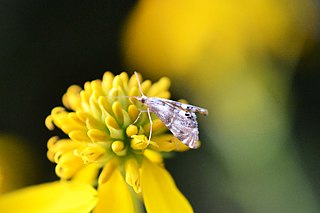
Anageshna is a monotypic moth genus of the family Crambidae described by Eugene G. Munroe in 1956. Its only species, Anageshna primordialis, the yellow-spotted webworm, was described by Harrison Gray Dyar Jr. in 1907. It is found in the US states of Alabama, Arkansas, Arizona, Florida, Georgia, Iowa, Illinois, Kansas, Louisiana, Massachusetts, Maryland, Maine, Minnesota, Missouri, Mississippi, North Carolina, New Hampshire, New Jersey, New York, Ohio, Oklahoma, Pennsylvania, South Carolina, Texas, Virginia and West Virginia.
Cosipara is a genus of moths of the family Crambidae.

Eudonia is a large and widespread genus in the grass moth family (Crambidae), subfamily Scopariinae. There is no common name for the roughly 250 species placed here; new species are still being described regularly. Although the genus was proposed early in the 19th century, many of these moths were for a long time retained in Scoparia, the type genus of the subfamily and a close relative of Eudonia. A few small genera have been proposed for separation from Eudonia, but given the size of this group this is not particularly convincing; thus, all are retained here pending a comprehensive phylogenetic review.

Petrophila is a genus of moths of the family Crambidae. The genus was described by Lansdown Guilding in 1830.

Scoparia is a grass moth genus of subfamily Scopariinae. Some authors have assigned the synonymous taxon Sineudonia to the snout moth family (Pyralidae), where all grass moths were once also included, but this seems to be in error.

Eudonia echo is a moth of the family Crambidae described by Harrison Gray Dyar Jr. in 1929. It is found in western North America from British Columbia to California.

Glaphyriinae is a subfamily of the lepidopteran family Crambidae. It was described by William Trowbridge Merrifield Forbes in 1923. The subfamily currently comprises 509 species in 75 genera.

Scopariinae is a subfamily of the lepidopteran family Crambidae. The subfamily was described by Achille Guenée in 1854.

Eudonia leucophthalma is a moth in the family Crambidae. It was described by Harrison Gray Dyar Jr. in 1929. It is found in North America, where it has been recorded from British Columbia and Alberta to Washington and California.
Eudonia torniplagalis is a moth in the family Crambidae. It was described by Harrison Gray Dyar Jr. in 1904. It is found in North America, where it has been recorded from South Dakota, the Rocky Mountains, the mountains of the south-western United States and from British Columbia to southern California.
Scoparia apachealis is a moth in the family Crambidae. It was described by Eugene G. Munroe in 1972. It is found in North America, where it has been recorded from Arizona, New Mexico and Utah.
Scoparia blanchardi is a moth in the family Crambidae. It was described by Eugene G. Munroe in 1972. It is found in North America, where it has been recorded from Texas.
Scoparia californialis is a moth in the family Crambidae. It was described by Eugene G. Munroe in 1972. It is found in North America, where it has been recorded from California.
Scoparia cinereomedia is a moth in the family Crambidae. It was described by Harrison Gray Dyar Jr. in 1904. It is found in North America, where it has been recorded from British Columbia, Kentucky, Maine, Manitoba, Maryland, New Brunswick, New Hampshire, North Carolina, Nova Scotia, Ohio, Ontario, Quebec, South Carolina, Tennessee, Virginia and West Virginia.
Scoparia denigata is a moth in the family Crambidae. It was described by Harrison Gray Dyar Jr. in 1929. It has been recorded from the US state of Arizona.
Scoparia dominicki is a moth in the family Crambidae. It was described by Eugene G. Munroe in 1972. It is found in North America, where it has been recorded from Florida, North Carolina, Oklahoma, South Carolina and West Virginia.
Scoparia huachucalis is a moth in the family Crambidae. It was described by Eugene G. Munroe in 1972. It is found in North America, where it has been recorded from Arizona.
Scoparia normalis is a moth in the family Crambidae. It was described by Harrison Gray Dyar Jr. in 1904. It has been recorded from the US states of Arizona, Colorado, New Mexico, North Carolina and Utah.
Scoparia penumbralis, the dark-brown scoparia moth, is a moth in the family Crambidae. It was described by Harrison Gray Dyar Jr. in 1906. It is found in North America, where it has been recorded from Alabama, Maine, Maryland, Massachusetts, Michigan, Minnesota, Newfoundland, North Carolina, Nova Scotia, Ohio, Ontario, Quebec, South Carolina, Tennessee, West Virginia and Wisconsin.
Scoparia ruidosalis is a moth in the family Crambidae. It was described by Eugene G. Munroe in 1972. It is found in North America, where it has been recorded from New Mexico.








